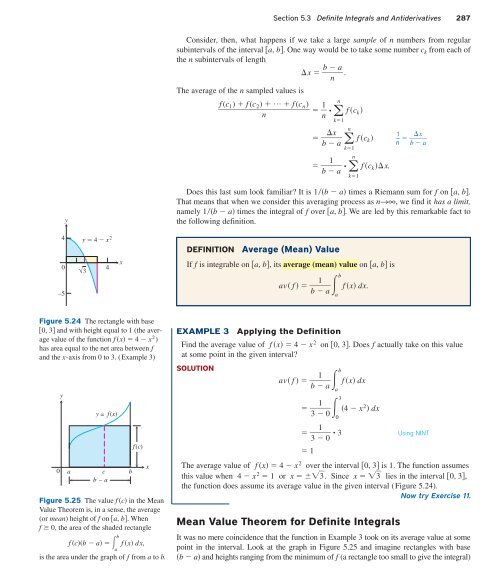FDWK_3ed_Ch05_pp262-319
FDWK_3ed_Ch05_pp262-319
FDWK_3ed_Ch05_pp262-319
You also want an ePaper? Increase the reach of your titles
YUMPU automatically turns print PDFs into web optimized ePapers that Google loves.
Section 5.3 Definite Integrals and Antiderivatives 287<br />
Consider, then, what happens if we take a large sample of n numbers from regular<br />
subintervals of the interval a, b. One way would be to take some number c k from each of<br />
the n subintervals of length<br />
x b a<br />
.<br />
n<br />
The average of the n sampled values is<br />
f (c 1 ) f (c 2 ) … f (c n )<br />
<br />
n<br />
1 n • n<br />
k1<br />
n<br />
x<br />
b a <br />
f c k <br />
k1<br />
1<br />
•<br />
b a n<br />
k1<br />
f c k <br />
f c k x.<br />
1 n x<br />
<br />
b a<br />
y<br />
Does this last sum look familiar It is 1b a times a Riemann sum for f on a, b.<br />
That means that when we consider this averaging process as n→∞, we find it has a limit,<br />
namely 1b a times the integral of f over a, b. We are led by this remarkable fact to<br />
the following definition.<br />
4 y 4 x 2<br />
0<br />
√3<br />
4<br />
–5<br />
x<br />
DEFINITION Average (Mean) Value<br />
If f is integrable on a, b, its average (mean) value on a, b is<br />
b<br />
1<br />
av f b a<br />
a<br />
f x dx.<br />
Figure 5.24 The rectangle with base<br />
0, 3 and with height equal to 1 (the average<br />
value of the function f x 4 x 2 )<br />
has area equal to the net area between f<br />
and the x-axis from 0 to 3. (Example 3)<br />
y<br />
y = f(x)<br />
0 a c<br />
b – a<br />
b<br />
f(c)<br />
Figure 5.25 The value f c in the Mean<br />
Value Theorem is, in a sense, the average<br />
(or mean) height of f on a, b. When<br />
f 0, the area of the shaded rectangle<br />
f cb a b<br />
f x dx,<br />
is the area under the graph of f from a to b.<br />
a<br />
x<br />
EXAMPLE 3<br />
Applying the Definition<br />
Find the average value of f x 4 x 2 on 0, 3. Does f actually take on this value<br />
at some point in the given interval<br />
SOLUTION<br />
b<br />
a<br />
3<br />
1<br />
av f b a<br />
f x dx<br />
1<br />
4 x 3 0<br />
2 dx<br />
0<br />
1<br />
• 3 3 0<br />
1<br />
Using NINT<br />
The average value of f x 4 x 2 over the interval 0, 3 is 1. The function assumes<br />
this value when 4 x 2 1 or x 3. Since x 3 lies in the interval 0, 3,<br />
the function does assume its average value in the given interval (Figure 5.24).<br />
Now try Exercise 11.<br />
Mean Value Theorem for Definite Integrals<br />
It was no mere coincidence that the function in Example 3 took on its average value at some<br />
point in the interval. Look at the graph in Figure 5.25 and imagine rectangles with base<br />
b a and heights ranging from the minimum of f (a rectangle too small to give the integral)


